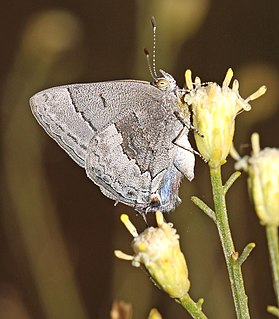
The Neotropical realm is one of the eight biogeographic realms constituting Earth's land surface. Physically, it includes the tropical terrestrial ecoregions of the Americas and the entire South American temperate zone.

Clytie, or Clytia is a water nymph, daughter of the Titans Oceanus and Tethys in Greek mythology. She is one of the 3,000 Oceanid nymphs, thus sister to the Potamoi (river-gods). Clytia loved the god of the sun Helios in vain, but he left her for another woman, the princess Leucothoe, under the influence of Aphrodite, the goddess of love. In anger and bitterness, she revealed their affair to the girl's father, indirectly causing her doom as the king buried her alive. This failed to win Helios back to her, and she was left lovingly staring at him from the ground; eventually she turned into a heliotrope, a violet flower that gazes at the Sun.

Apatura ilia, the lesser purple emperor, is a species of butterfly native to most of Europe and east across the Palearctic. It is named for its similarity to the purple emperor butterfly.

Abies religiosa, the oyamel fir or sacred fir, is a fir native to the mountains of central and southern Mexico and western Guatemala. It grows at high altitudes of 2,100–4,100 metres (6,900–13,500 ft) in cloud forests with cool, humid summers and dry winters in most of its habitat regime. In the state of Veracruz, it grows with precipitation all year long. The tree is resistant to regular winter snowfalls.

USS Clytie (AS-26) was an Aegir-class submarine tender in the United States Navy during World War II.

The Trans-Mexican Volcanic Belt pine–oak forests is a subtropical coniferous forest ecoregion of the Trans-Mexican Volcanic Belt of central Mexico.

Angangueo is a municipality located in far eastern Michoacán state in central Mexico noted for its history of mining and its location in the Monarch Butterfly Biosphere Reserve. The municipal seat is the Mineral de Angangueo. It is located in high rugged forested mountains, with the town in a small canyon.

The Monarch Butterfly Biosphere Reserve is a World Heritage Site containing most of the over-wintering sites of the eastern population of the monarch butterfly. The reserve is located in the Trans-Mexican Volcanic Belt pine-oak forests ecoregion on the border of Michoacán and State of Mexico, 100 km, northwest of Mexico City. Millions of butterflies arrive in the reserve annually. Butterflies only inhabit a fraction of the 56,000 hectares of the reserve from October–March. The biosphere’s mission is to protect the butterfly species and its habitat.

Ministrymon is a genus of butterflies in the family Lycaenidae. The species of this genus are found in the Nearctic and Neotropical realms.
Clytie is a genus of moths in the family Erebidae. The genus was erected by Jacob Hübner in 1823.

Ministrymon janevicroy, the Vicroy's ministreak, is a butterfly in the family Lycaenidae. It is found from the southern United States (Texas) to Costa Rica (Guanacaste). There are disjunct populations on the Venezuelan islands of Curaçao and Isla Margarita. The habitat consists of dry deciduous forests and scrubs.

Ministrymon azia, the gray ministreak, is a butterfly in the family Lycaenidae. It is found from the southern United States to southern Brazil, Paraguay and Argentina. It is found in virtually all lowland habitats, ranging from deserts in coastal Peru and Chile to rainforests in the Amazon basin.

The forests of Mexico cover a surface area of about 64 million hectares, or 34.5% of the country. These forests are categorized by the type of tree and biome: tropical forests, temperate forests, cloud forests, riparian forests, deciduous, evergreen, dry, moist, etc.. The agency in charge of Mexico's forests is the Comisión Nacional Forestal. Despite major reforms to the Mexican Constitution in 1992 regarding private land, Mexico would later enact major forest regulation laws in 1998 and 2003. Though no longer required to enforce land regulation in Mexico, Article 27 of the Mexican Constitution also still permits the Mexican Government to enact land regulation.

Ministrymon leda, the leda ministreak, is a species of hairstreak in the butterfly family Lycaenidae. It is found in North America.













